Is Pakistan’s Public Debt Becoming ‘Unsustainable’ at $286 Billion by FY25?

Synopsis
Key Takeaways
- Pakistan's public debt has reached $286 billion.
- The debt-to-GDP ratio is now at 70%.
- Fiscal deficit for the year stands at $25.2 billion.
- Domestic debt accounts for $194 billion, a 15% increase.
- External debt has risen to $92.5 billion.
New Delhi, Oct 25 (NationPress) Pakistan's overall public debt has surged to $286 billion by the conclusion of the 2024–25 fiscal year, marking a troubling rise to an 'unsustainable' level, according to a recent report. This figure, reflecting a 13 percent increase from the preceding year, highlights a fragile economic recovery alongside the significant structural issues that characterize Pakistan’s fiscal management, as outlined in the report from Maldives Insight.
According to the report, Pakistan’s economy is not growing swiftly enough to manage its liabilities, with borrowing habits being both routine and unsustainable. The report emphasizes that debt servicing, rather than fostering growth, has become the primary allocation of public resources.
The ‘Annual Debt Review 2025’ from Pakistan's Ministry of Finance acknowledges an increase in the debt-to-GDP ratio, which now stands at 70 percent, up from 68 percent the previous year.
This fiscal year, Pakistan’s deficit reached $25.2 billion, primarily funded through domestic borrowing. The report indicates that domestic debt alone has risen to $194 billion, a jump of 15 percent year-on-year.
On the other hand, external debt has climbed to $92.5 billion, reflecting a 6 percent increase. The ministry has reported an average maturity period for domestic debt of 3.8 years and a decrease in the share of external debt. However, interest costs have surged by 9 percent year-on-year, constraining development spending, as per the report.
Multilateral loans comprise 57 percent of total external debt, with bilateral loans making up 26 percent, while the remaining portion includes commercial borrowing, such as Eurobonds. The report suggests that these figures illustrate the degree to which Pakistan's economic sovereignty relies on the conditions set by external financiers.
Ultimately, Pakistan's economy remains incapable of generating adequate revenue to sustain itself without ongoing borrowing.
While the country’s debt profile may appear more 'manageable' on paper, the actual economy is fragile, heavily reliant on external bailouts and domestic credit challenges.










